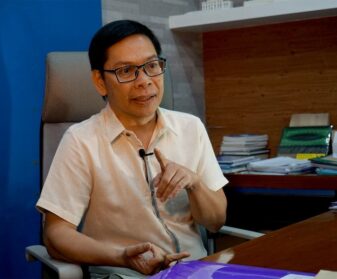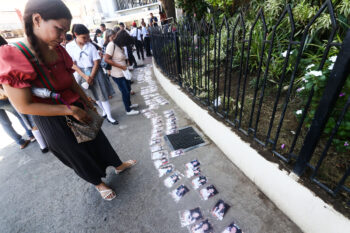DAVAO CITY (MindaNews/22 Feb) — I thought the country was looking for a way of doing responsible mining. And that the Aquino administration was serious in pursuing this.
There are those, of course, who do not believe that responsible mining is at all possible in an archipelago like the Philippines. Where you have a tropical paradise of 7,200 islands with its rich environmental treasures, it is not responsible, they contend, to allow foreigners to destroy the paradise and take away the treasures for returns to the country that are far too small.
In its issuance of EO 79, the Aquino Administration seemed at least to acknowledge the financial problem. Under the current law, it acknowledged the Philippines’ cut in the value of the minerals themselves – “from zero to nil” according to SC Justice Carpio – was too small. By declaring it would issue no new mining permits to companies without Congress first defining a more rational regime of sharing, it seemed to be open to more rationality in mining.
But rationalizing the fiscal regime is only one aspect of responsible mining. There are others – like rationalizing the impact of mining on the environment and rationalizing the impact of mining on the people.
Under current policy, for a company like SMI that had already received its mining permit long before EO 79 was issued, it needs an Environmental Clearance Certificate (ECC) in order to implement its mining plans. It is simple. If a company fulfills conditions that adequately protect the environment, then the permit is issued.
In the case of SMI, however, the Department of Environment and Natural Resources (DENR) has issued a “conditional ECC.” What, pray tell, is that? It is an issuance which permits SMI to operate on the condition that it fulfills certain stringent conditions on pain of cancellation of the ECC. It sets conditions, but it sets no clear deadlines as to when conditions must be met. It undertakes to “strictly monitor” the compliance of SMI, where the conditions of strictness are fuzzy.
Normally, an ECC is issued under clear compliance by a mining firm with conditions of environmental acceptability. Environmentalists have been monitoring these closely. SMI has not complied with these conditions; nevertheless, it is being permitted to operate conditionally. It is like an elephant in a shop of precious crystals. If it is clear the elephant will not destroy the crystal in the shop, then it can be permitted to dance. That’s the normal ECC. But the DENR’s preposterous “conditional ECC” is: the elephant in the crystal shop is permitted to dance, on the condition that it will not break the crystal, and with the public assurance that it will “strictly monitor” that when the elephant begins breaking the crystal, it will cancel the permit. So, elephant, dance!
Where is the responsibility here? Where is the rationality?
From SMI’s environmental impact statement itself, it is known that the mining site is in an area of high seismic activity, just 12 kilometers away from Mt. Matutom, still classified as active.
SMI will clear 3,935 hectares of forest – including 1,350 hectares of protected rainforest. It threatens 812 flora species, 247 of which are Philippine endemics and 52 of which are mainland Mindanao endemics.
55 species are under the Threatened Species list of the International Union for the Conservation of Nature. For amphibians and reptiles alone, 28% are Philippine endemics and 20% are Greater Mindanao endemics.
With its 500-hectare large pit with the depth of two stacked Empire State Buildings and its similarly large fresh-water catchment, it will adversely affect the fresh water supply of the Koronadal Valley, including its irrigation system, and threaten its shallow aquafers with toxicity. The Mal River will be worst affected through the SMI construction of a fresh water dam just above the NIA’s irrigation dam.
Indeed, while hydrogeological studies are ongoing, there is little doubt that SMI will adversely affect the Mindanao’s entire riverine system.
Climate change – bringing such a Typhoon Pablo to Mindanao (which is scientifically impossible according to present weather paradigms) and snow to deserts in Arizona and New Mexico – is real., but not at all considered in the Environmental Impact Statement of the SMI project. Where climate change will certainly bring up the temperature in Mindanao, preserving the water system is imperative. SMI will harm it.
Finally, the mine is in a highly unstable social area where not only old forests but the indigenous B’laans are to be displaced to make way for SMI’s open pit and fresh water catchment and toxic-waste mountain, and where the Free and Informed Prior Consent (FIPC) of most of the B’laans has not been secured. In fact, instead of the FIPC, there have been ugly killings of B’laans who have stood up to fight the mines, including Atari and Daguil Capion. Just yesterday, the Capions testified before a congressional committee in Koronadal how their relatives had been massacred. Here, unfortunately, the military and the police are implicated.
Meanwhile, 40,000 Muslims depend on fishing in Lake Buluan, almost certainly to be adversely affected by the SMI project.
With all of this, why was this irrational “conditional ECC” issued? Was it to keep faith with a foreign company as the cost of betraying the interests of the People, especially the interests of Mindanao.? I would have expected that the tailings dam spill of Philex in Benguet would have made our DENR more cautious in issuing an ECC to a large-scale mining company on claiming to possess “world-class technology.” Instead, it has become more reckless.
Closing one’s eyes to socio-environmental problems, no matter how tightly, doesn’t make them go away. Giving a company a conditional ECC with no deadlines to fulfill the conditions, when the company has already announced plans not to follow the conditions, is not rational. This is so especially in the matter of the open pit. The South Cotabato local government has proscribed open-pit mining. SMI has said it will use open-pit mining. DENR has said it permits SMI to mine on condition that it does not do open pit mining even though it has repeatedly said it would. What DENR did was issue and Environmental Catastrophe Certificate. And encourage further bullying and killings by military of the B’laans. It has lit the fuse to a Mindanao conflagration.
For this, unfortunately, President Noynoy Aquino is responsible. It is his call. But here, he errs. Because of a weak economic argument, he is betraying the environment and threatening the peace in Mindanao that he otherwise so laudably pursues. In defense of foreign interests and their exclusive coterie of local capitalists, he pits the military against the Filipino indigenous peoples and drives them for protection to the New People’s Army. Amidst the fragile crystals of Mindanao, he encourages the elephant to dance.
(MindaViews is the opinion section of MindaNews. Fr. Joel Tabora, SJ, is president of the Ateneo de Davao University. This piece is from his blog, taborasj at http://taborasj.wordpress.com/)







